Evaluating Ipratropium Bromide Effectiveness and Safety
VerifiedAdded on 2021/04/17
|8
|2036
|75
AI Summary
This assignment involves evaluating the effectiveness and safety of ipratropium bromide in treating COPD. The student reflects on their understanding of the medication's role in managing bronchospasm exacerbations, its common side effects, and the importance of proper administration techniques. They also discuss how to minimize adverse events and collaborate with other professionals during care planning and delivery.
Contribute Materials
Your contribution can guide someone’s learning journey. Share your
documents today.
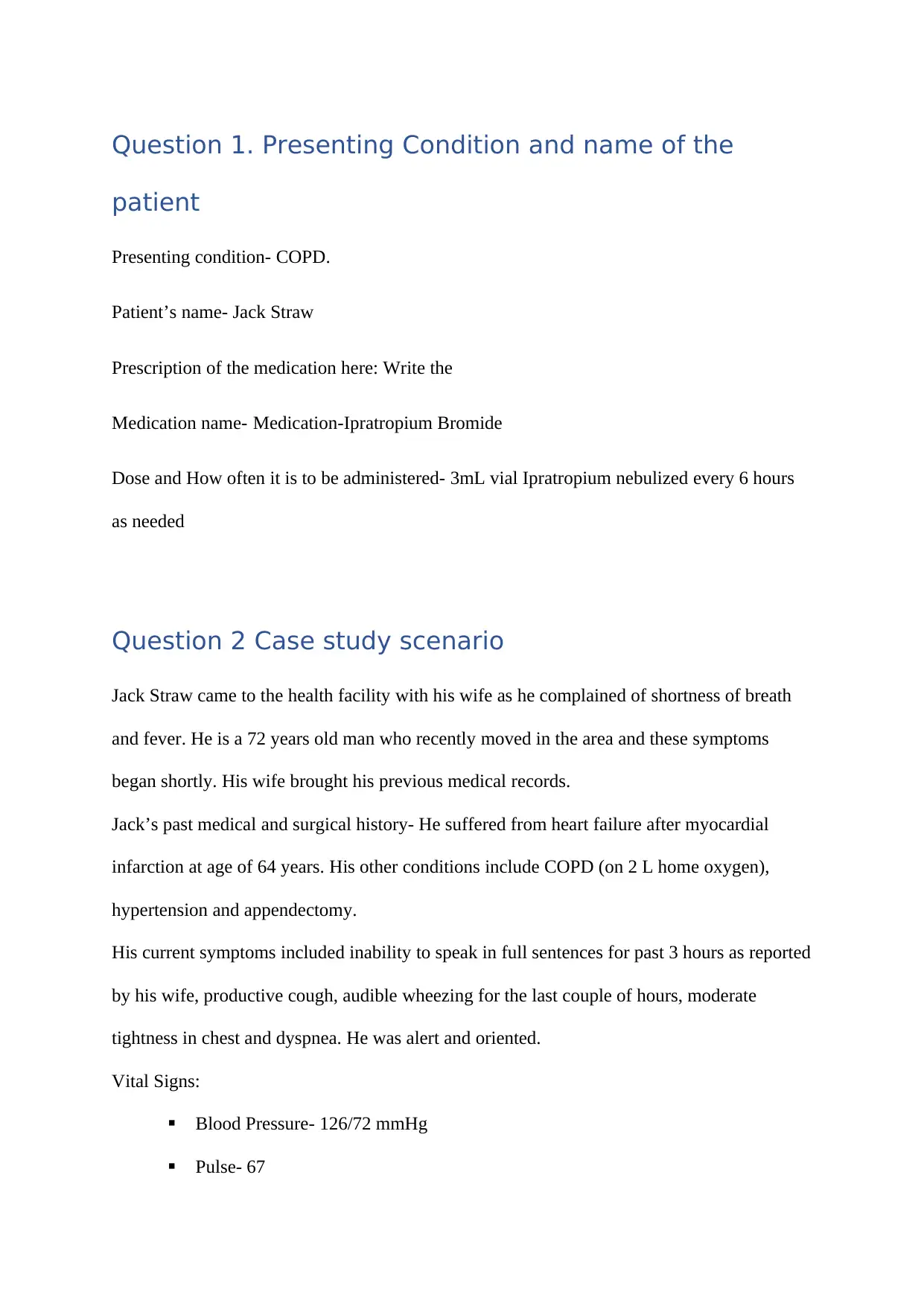
Question 1. Presenting Condition and name of the
patient
Presenting condition- COPD.
Patient’s name- Jack Straw
Prescription of the medication here: Write the
Medication name- Medication-Ipratropium Bromide
Dose and How often it is to be administered- 3mL vial Ipratropium nebulized every 6 hours
as needed
Question 2 Case study scenario
Jack Straw came to the health facility with his wife as he complained of shortness of breath
and fever. He is a 72 years old man who recently moved in the area and these symptoms
began shortly. His wife brought his previous medical records.
Jack’s past medical and surgical history- He suffered from heart failure after myocardial
infarction at age of 64 years. His other conditions include COPD (on 2 L home oxygen),
hypertension and appendectomy.
His current symptoms included inability to speak in full sentences for past 3 hours as reported
by his wife, productive cough, audible wheezing for the last couple of hours, moderate
tightness in chest and dyspnea. He was alert and oriented.
Vital Signs:
Blood Pressure- 126/72 mmHg
Pulse- 67
patient
Presenting condition- COPD.
Patient’s name- Jack Straw
Prescription of the medication here: Write the
Medication name- Medication-Ipratropium Bromide
Dose and How often it is to be administered- 3mL vial Ipratropium nebulized every 6 hours
as needed
Question 2 Case study scenario
Jack Straw came to the health facility with his wife as he complained of shortness of breath
and fever. He is a 72 years old man who recently moved in the area and these symptoms
began shortly. His wife brought his previous medical records.
Jack’s past medical and surgical history- He suffered from heart failure after myocardial
infarction at age of 64 years. His other conditions include COPD (on 2 L home oxygen),
hypertension and appendectomy.
His current symptoms included inability to speak in full sentences for past 3 hours as reported
by his wife, productive cough, audible wheezing for the last couple of hours, moderate
tightness in chest and dyspnea. He was alert and oriented.
Vital Signs:
Blood Pressure- 126/72 mmHg
Pulse- 67
Secure Best Marks with AI Grader
Need help grading? Try our AI Grader for instant feedback on your assignments.
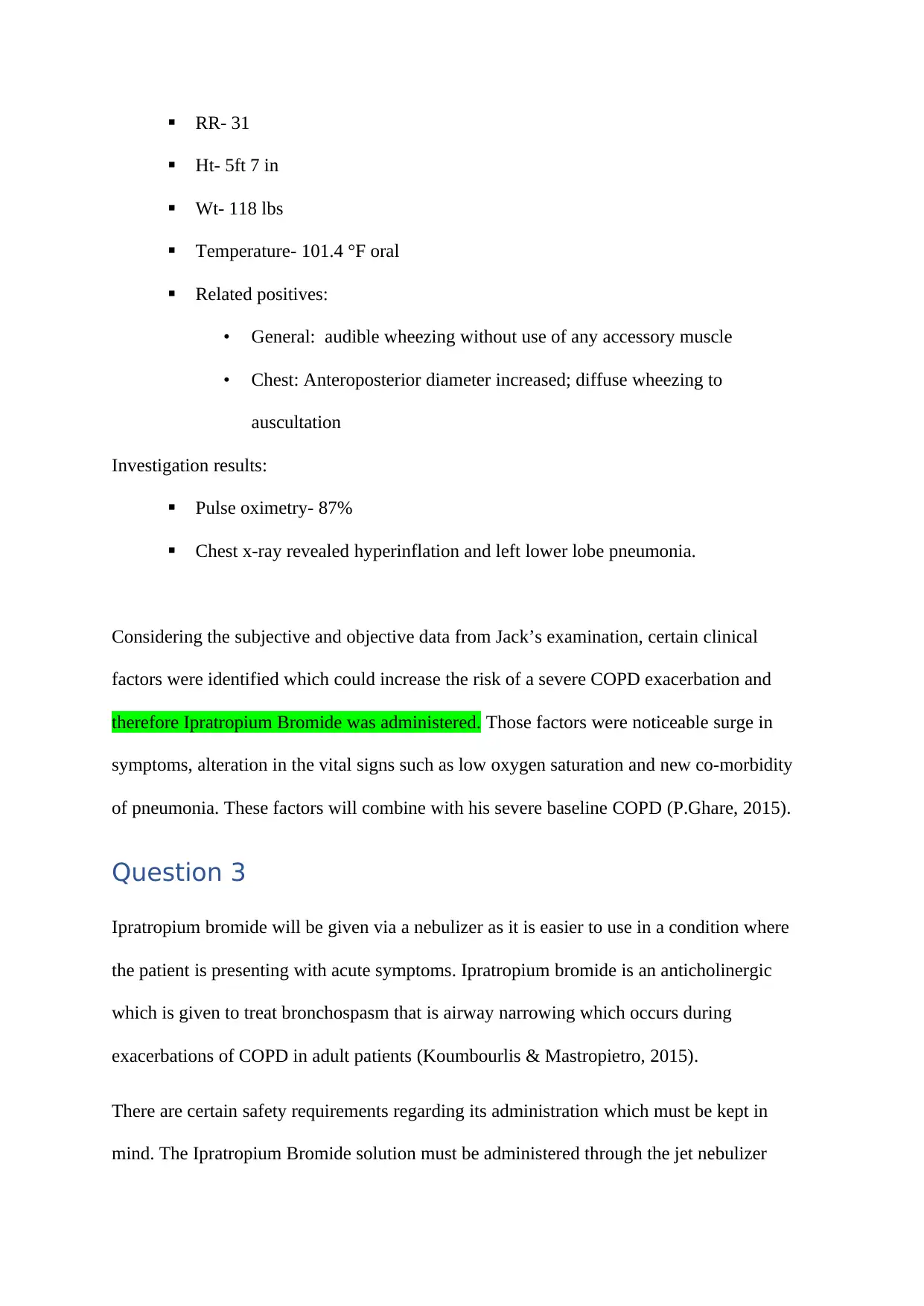
RR- 31
Ht- 5ft 7 in
Wt- 118 lbs
Temperature- 101.4 °F oral
Related positives:
• General: audible wheezing without use of any accessory muscle
• Chest: Anteroposterior diameter increased; diffuse wheezing to
auscultation
Investigation results:
Pulse oximetry- 87%
Chest x-ray revealed hyperinflation and left lower lobe pneumonia.
Considering the subjective and objective data from Jack’s examination, certain clinical
factors were identified which could increase the risk of a severe COPD exacerbation and
therefore Ipratropium Bromide was administered. Those factors were noticeable surge in
symptoms, alteration in the vital signs such as low oxygen saturation and new co-morbidity
of pneumonia. These factors will combine with his severe baseline COPD (P.Ghare, 2015).
Question 3
Ipratropium bromide will be given via a nebulizer as it is easier to use in a condition where
the patient is presenting with acute symptoms. Ipratropium bromide is an anticholinergic
which is given to treat bronchospasm that is airway narrowing which occurs during
exacerbations of COPD in adult patients (Koumbourlis & Mastropietro, 2015).
There are certain safety requirements regarding its administration which must be kept in
mind. The Ipratropium Bromide solution must be administered through the jet nebulizer
Ht- 5ft 7 in
Wt- 118 lbs
Temperature- 101.4 °F oral
Related positives:
• General: audible wheezing without use of any accessory muscle
• Chest: Anteroposterior diameter increased; diffuse wheezing to
auscultation
Investigation results:
Pulse oximetry- 87%
Chest x-ray revealed hyperinflation and left lower lobe pneumonia.
Considering the subjective and objective data from Jack’s examination, certain clinical
factors were identified which could increase the risk of a severe COPD exacerbation and
therefore Ipratropium Bromide was administered. Those factors were noticeable surge in
symptoms, alteration in the vital signs such as low oxygen saturation and new co-morbidity
of pneumonia. These factors will combine with his severe baseline COPD (P.Ghare, 2015).
Question 3
Ipratropium bromide will be given via a nebulizer as it is easier to use in a condition where
the patient is presenting with acute symptoms. Ipratropium bromide is an anticholinergic
which is given to treat bronchospasm that is airway narrowing which occurs during
exacerbations of COPD in adult patients (Koumbourlis & Mastropietro, 2015).
There are certain safety requirements regarding its administration which must be kept in
mind. The Ipratropium Bromide solution must be administered through the jet nebulizer
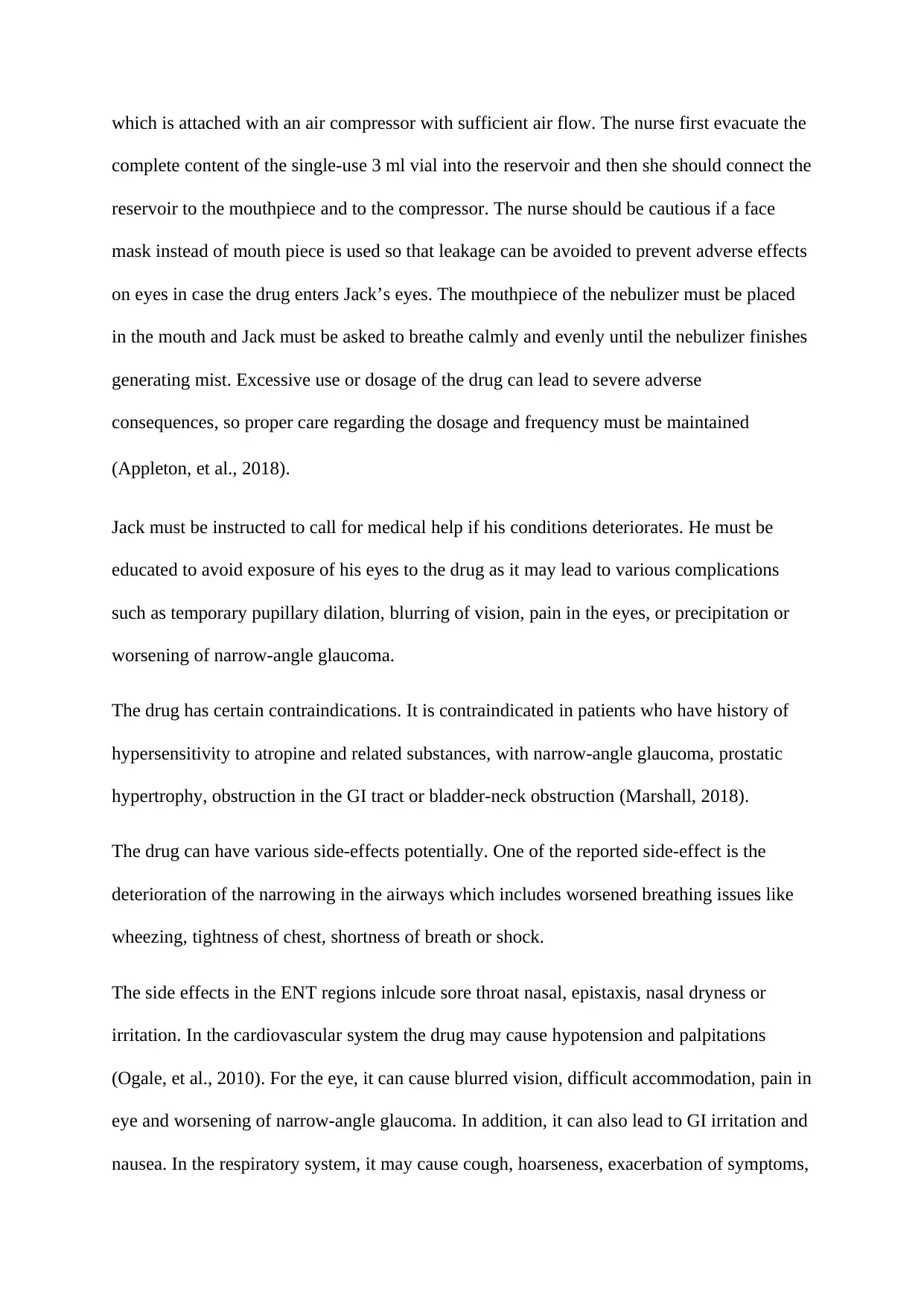
which is attached with an air compressor with sufficient air flow. The nurse first evacuate the
complete content of the single-use 3 ml vial into the reservoir and then she should connect the
reservoir to the mouthpiece and to the compressor. The nurse should be cautious if a face
mask instead of mouth piece is used so that leakage can be avoided to prevent adverse effects
on eyes in case the drug enters Jack’s eyes. The mouthpiece of the nebulizer must be placed
in the mouth and Jack must be asked to breathe calmly and evenly until the nebulizer finishes
generating mist. Excessive use or dosage of the drug can lead to severe adverse
consequences, so proper care regarding the dosage and frequency must be maintained
(Appleton, et al., 2018).
Jack must be instructed to call for medical help if his conditions deteriorates. He must be
educated to avoid exposure of his eyes to the drug as it may lead to various complications
such as temporary pupillary dilation, blurring of vision, pain in the eyes, or precipitation or
worsening of narrow-angle glaucoma.
The drug has certain contraindications. It is contraindicated in patients who have history of
hypersensitivity to atropine and related substances, with narrow-angle glaucoma, prostatic
hypertrophy, obstruction in the GI tract or bladder-neck obstruction (Marshall, 2018).
The drug can have various side-effects potentially. One of the reported side-effect is the
deterioration of the narrowing in the airways which includes worsened breathing issues like
wheezing, tightness of chest, shortness of breath or shock.
The side effects in the ENT regions inlcude sore throat nasal, epistaxis, nasal dryness or
irritation. In the cardiovascular system the drug may cause hypotension and palpitations
(Ogale, et al., 2010). For the eye, it can cause blurred vision, difficult accommodation, pain in
eye and worsening of narrow-angle glaucoma. In addition, it can also lead to GI irritation and
nausea. In the respiratory system, it may cause cough, hoarseness, exacerbation of symptoms,
complete content of the single-use 3 ml vial into the reservoir and then she should connect the
reservoir to the mouthpiece and to the compressor. The nurse should be cautious if a face
mask instead of mouth piece is used so that leakage can be avoided to prevent adverse effects
on eyes in case the drug enters Jack’s eyes. The mouthpiece of the nebulizer must be placed
in the mouth and Jack must be asked to breathe calmly and evenly until the nebulizer finishes
generating mist. Excessive use or dosage of the drug can lead to severe adverse
consequences, so proper care regarding the dosage and frequency must be maintained
(Appleton, et al., 2018).
Jack must be instructed to call for medical help if his conditions deteriorates. He must be
educated to avoid exposure of his eyes to the drug as it may lead to various complications
such as temporary pupillary dilation, blurring of vision, pain in the eyes, or precipitation or
worsening of narrow-angle glaucoma.
The drug has certain contraindications. It is contraindicated in patients who have history of
hypersensitivity to atropine and related substances, with narrow-angle glaucoma, prostatic
hypertrophy, obstruction in the GI tract or bladder-neck obstruction (Marshall, 2018).
The drug can have various side-effects potentially. One of the reported side-effect is the
deterioration of the narrowing in the airways which includes worsened breathing issues like
wheezing, tightness of chest, shortness of breath or shock.
The side effects in the ENT regions inlcude sore throat nasal, epistaxis, nasal dryness or
irritation. In the cardiovascular system the drug may cause hypotension and palpitations
(Ogale, et al., 2010). For the eye, it can cause blurred vision, difficult accommodation, pain in
eye and worsening of narrow-angle glaucoma. In addition, it can also lead to GI irritation and
nausea. In the respiratory system, it may cause cough, hoarseness, exacerbation of symptoms,
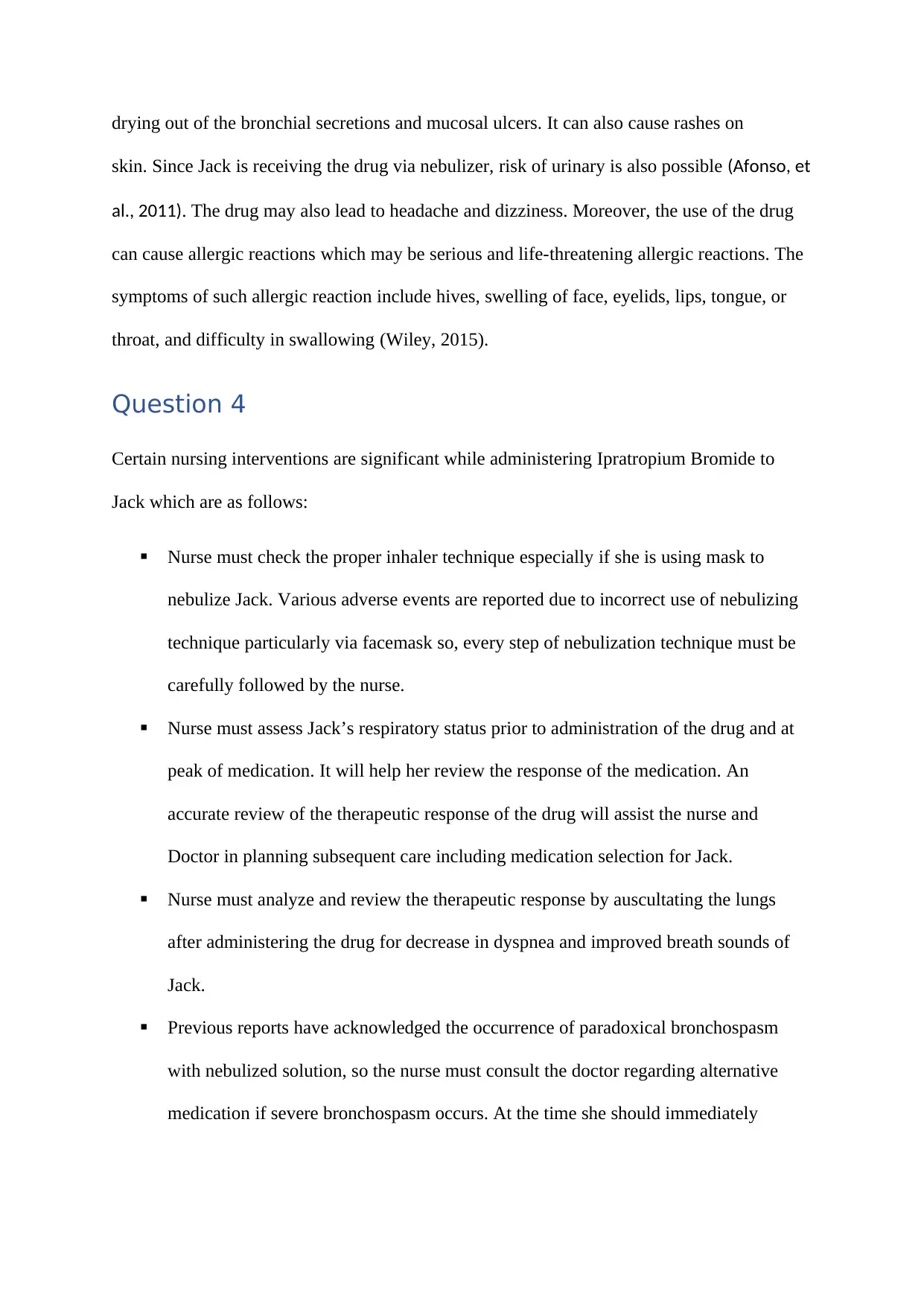
drying out of the bronchial secretions and mucosal ulcers. It can also cause rashes on
skin. Since Jack is receiving the drug via nebulizer, risk of urinary is also possible (Afonso, et
al., 2011). The drug may also lead to headache and dizziness. Moreover, the use of the drug
can cause allergic reactions which may be serious and life-threatening allergic reactions. The
symptoms of such allergic reaction include hives, swelling of face, eyelids, lips, tongue, or
throat, and difficulty in swallowing (Wiley, 2015).
Question 4
Certain nursing interventions are significant while administering Ipratropium Bromide to
Jack which are as follows:
Nurse must check the proper inhaler technique especially if she is using mask to
nebulize Jack. Various adverse events are reported due to incorrect use of nebulizing
technique particularly via facemask so, every step of nebulization technique must be
carefully followed by the nurse.
Nurse must assess Jack’s respiratory status prior to administration of the drug and at
peak of medication. It will help her review the response of the medication. An
accurate review of the therapeutic response of the drug will assist the nurse and
Doctor in planning subsequent care including medication selection for Jack.
Nurse must analyze and review the therapeutic response by auscultating the lungs
after administering the drug for decrease in dyspnea and improved breath sounds of
Jack.
Previous reports have acknowledged the occurrence of paradoxical bronchospasm
with nebulized solution, so the nurse must consult the doctor regarding alternative
medication if severe bronchospasm occurs. At the time she should immediately
skin. Since Jack is receiving the drug via nebulizer, risk of urinary is also possible (Afonso, et
al., 2011). The drug may also lead to headache and dizziness. Moreover, the use of the drug
can cause allergic reactions which may be serious and life-threatening allergic reactions. The
symptoms of such allergic reaction include hives, swelling of face, eyelids, lips, tongue, or
throat, and difficulty in swallowing (Wiley, 2015).
Question 4
Certain nursing interventions are significant while administering Ipratropium Bromide to
Jack which are as follows:
Nurse must check the proper inhaler technique especially if she is using mask to
nebulize Jack. Various adverse events are reported due to incorrect use of nebulizing
technique particularly via facemask so, every step of nebulization technique must be
carefully followed by the nurse.
Nurse must assess Jack’s respiratory status prior to administration of the drug and at
peak of medication. It will help her review the response of the medication. An
accurate review of the therapeutic response of the drug will assist the nurse and
Doctor in planning subsequent care including medication selection for Jack.
Nurse must analyze and review the therapeutic response by auscultating the lungs
after administering the drug for decrease in dyspnea and improved breath sounds of
Jack.
Previous reports have acknowledged the occurrence of paradoxical bronchospasm
with nebulized solution, so the nurse must consult the doctor regarding alternative
medication if severe bronchospasm occurs. At the time she should immediately
Secure Best Marks with AI Grader
Need help grading? Try our AI Grader for instant feedback on your assignments.
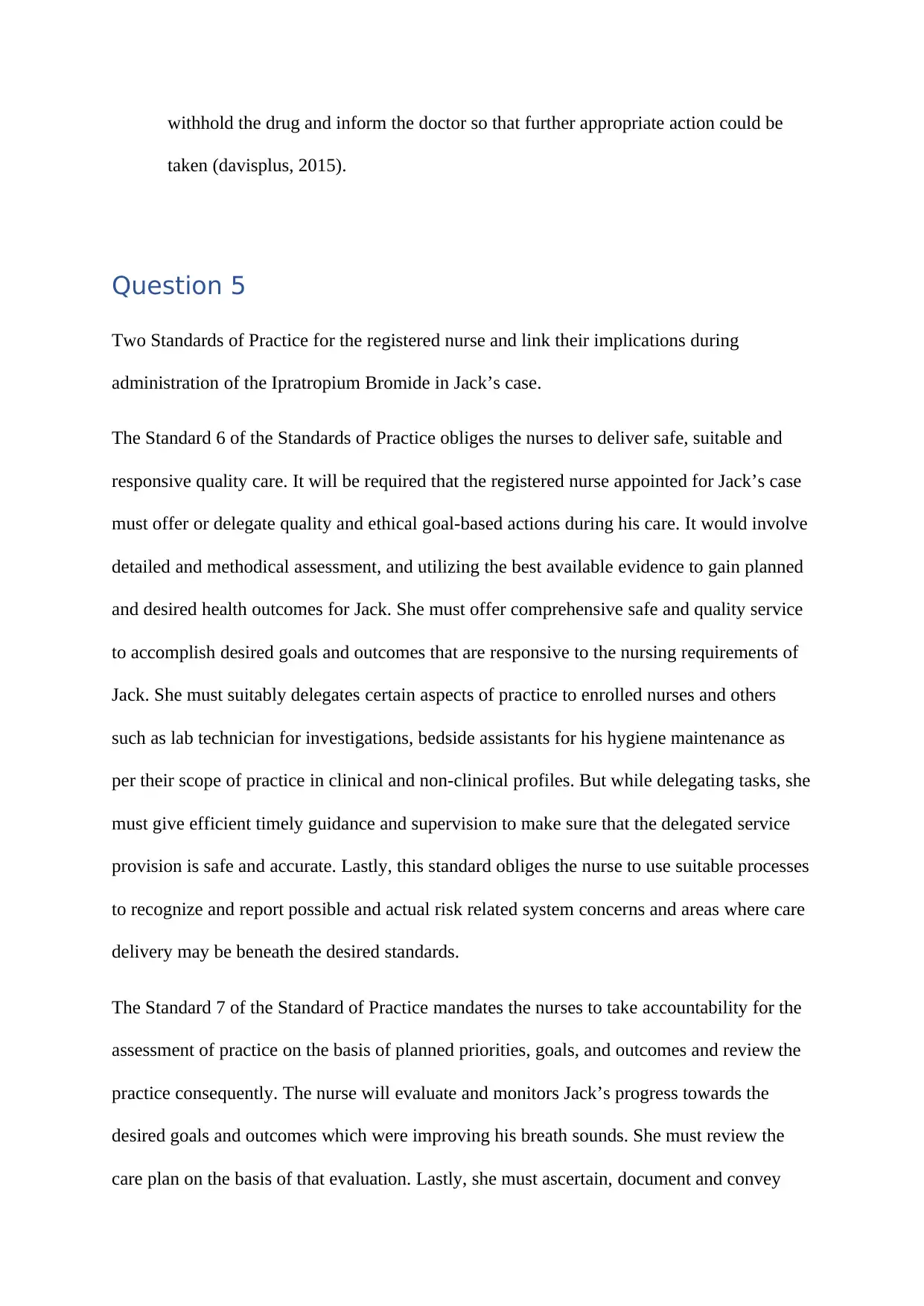
withhold the drug and inform the doctor so that further appropriate action could be
taken (davisplus, 2015).
Question 5
Two Standards of Practice for the registered nurse and link their implications during
administration of the Ipratropium Bromide in Jack’s case.
The Standard 6 of the Standards of Practice obliges the nurses to deliver safe, suitable and
responsive quality care. It will be required that the registered nurse appointed for Jack’s case
must offer or delegate quality and ethical goal-based actions during his care. It would involve
detailed and methodical assessment, and utilizing the best available evidence to gain planned
and desired health outcomes for Jack. She must offer comprehensive safe and quality service
to accomplish desired goals and outcomes that are responsive to the nursing requirements of
Jack. She must suitably delegates certain aspects of practice to enrolled nurses and others
such as lab technician for investigations, bedside assistants for his hygiene maintenance as
per their scope of practice in clinical and non-clinical profiles. But while delegating tasks, she
must give efficient timely guidance and supervision to make sure that the delegated service
provision is safe and accurate. Lastly, this standard obliges the nurse to use suitable processes
to recognize and report possible and actual risk related system concerns and areas where care
delivery may be beneath the desired standards.
The Standard 7 of the Standard of Practice mandates the nurses to take accountability for the
assessment of practice on the basis of planned priorities, goals, and outcomes and review the
practice consequently. The nurse will evaluate and monitors Jack’s progress towards the
desired goals and outcomes which were improving his breath sounds. She must review the
care plan on the basis of that evaluation. Lastly, she must ascertain, document and convey
taken (davisplus, 2015).
Question 5
Two Standards of Practice for the registered nurse and link their implications during
administration of the Ipratropium Bromide in Jack’s case.
The Standard 6 of the Standards of Practice obliges the nurses to deliver safe, suitable and
responsive quality care. It will be required that the registered nurse appointed for Jack’s case
must offer or delegate quality and ethical goal-based actions during his care. It would involve
detailed and methodical assessment, and utilizing the best available evidence to gain planned
and desired health outcomes for Jack. She must offer comprehensive safe and quality service
to accomplish desired goals and outcomes that are responsive to the nursing requirements of
Jack. She must suitably delegates certain aspects of practice to enrolled nurses and others
such as lab technician for investigations, bedside assistants for his hygiene maintenance as
per their scope of practice in clinical and non-clinical profiles. But while delegating tasks, she
must give efficient timely guidance and supervision to make sure that the delegated service
provision is safe and accurate. Lastly, this standard obliges the nurse to use suitable processes
to recognize and report possible and actual risk related system concerns and areas where care
delivery may be beneath the desired standards.
The Standard 7 of the Standard of Practice mandates the nurses to take accountability for the
assessment of practice on the basis of planned priorities, goals, and outcomes and review the
practice consequently. The nurse will evaluate and monitors Jack’s progress towards the
desired goals and outcomes which were improving his breath sounds. She must review the
care plan on the basis of that evaluation. Lastly, she must ascertain, document and convey
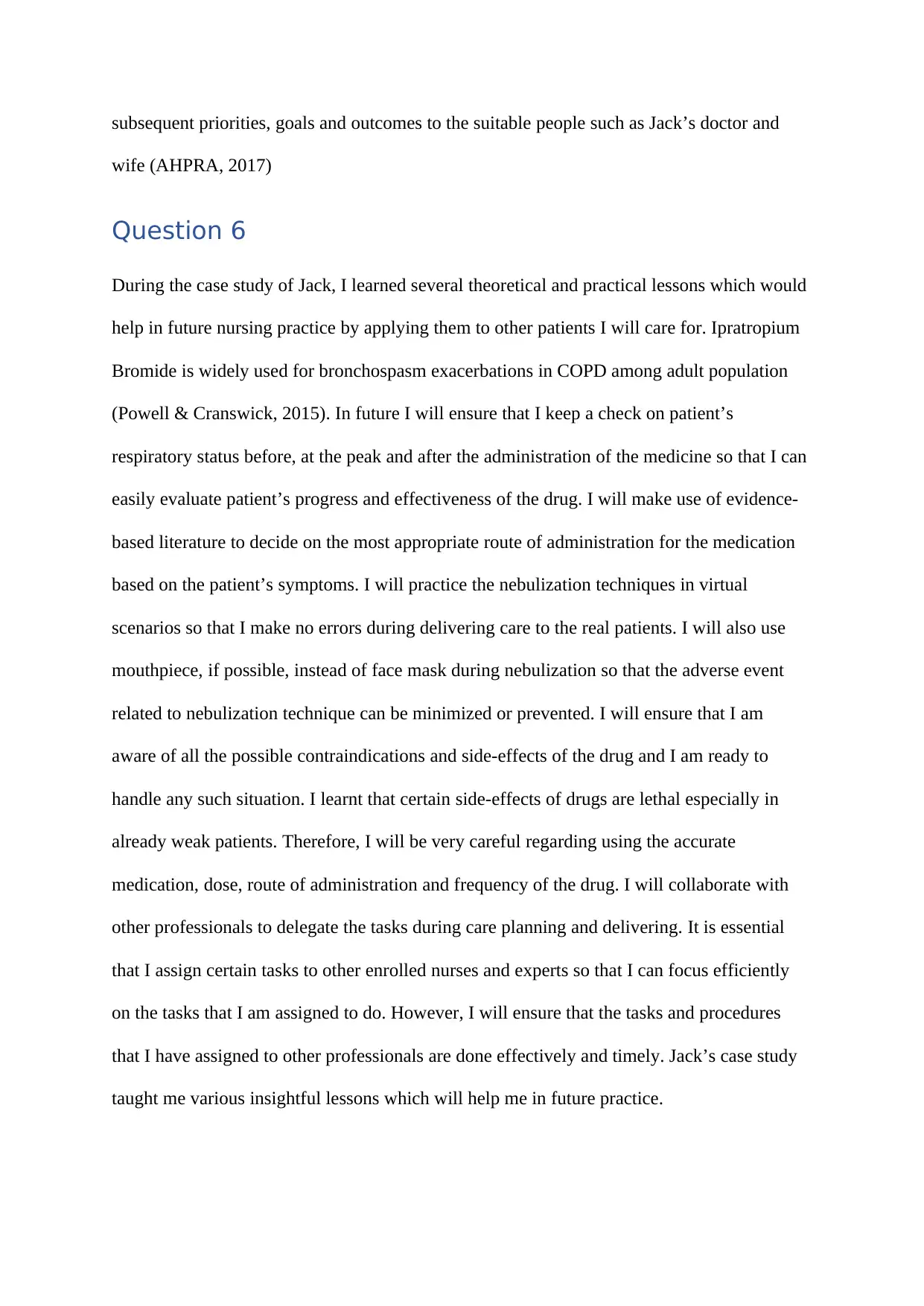
subsequent priorities, goals and outcomes to the suitable people such as Jack’s doctor and
wife (AHPRA, 2017)
Question 6
During the case study of Jack, I learned several theoretical and practical lessons which would
help in future nursing practice by applying them to other patients I will care for. Ipratropium
Bromide is widely used for bronchospasm exacerbations in COPD among adult population
(Powell & Cranswick, 2015). In future I will ensure that I keep a check on patient’s
respiratory status before, at the peak and after the administration of the medicine so that I can
easily evaluate patient’s progress and effectiveness of the drug. I will make use of evidence-
based literature to decide on the most appropriate route of administration for the medication
based on the patient’s symptoms. I will practice the nebulization techniques in virtual
scenarios so that I make no errors during delivering care to the real patients. I will also use
mouthpiece, if possible, instead of face mask during nebulization so that the adverse event
related to nebulization technique can be minimized or prevented. I will ensure that I am
aware of all the possible contraindications and side-effects of the drug and I am ready to
handle any such situation. I learnt that certain side-effects of drugs are lethal especially in
already weak patients. Therefore, I will be very careful regarding using the accurate
medication, dose, route of administration and frequency of the drug. I will collaborate with
other professionals to delegate the tasks during care planning and delivering. It is essential
that I assign certain tasks to other enrolled nurses and experts so that I can focus efficiently
on the tasks that I am assigned to do. However, I will ensure that the tasks and procedures
that I have assigned to other professionals are done effectively and timely. Jack’s case study
taught me various insightful lessons which will help me in future practice.
wife (AHPRA, 2017)
Question 6
During the case study of Jack, I learned several theoretical and practical lessons which would
help in future nursing practice by applying them to other patients I will care for. Ipratropium
Bromide is widely used for bronchospasm exacerbations in COPD among adult population
(Powell & Cranswick, 2015). In future I will ensure that I keep a check on patient’s
respiratory status before, at the peak and after the administration of the medicine so that I can
easily evaluate patient’s progress and effectiveness of the drug. I will make use of evidence-
based literature to decide on the most appropriate route of administration for the medication
based on the patient’s symptoms. I will practice the nebulization techniques in virtual
scenarios so that I make no errors during delivering care to the real patients. I will also use
mouthpiece, if possible, instead of face mask during nebulization so that the adverse event
related to nebulization technique can be minimized or prevented. I will ensure that I am
aware of all the possible contraindications and side-effects of the drug and I am ready to
handle any such situation. I learnt that certain side-effects of drugs are lethal especially in
already weak patients. Therefore, I will be very careful regarding using the accurate
medication, dose, route of administration and frequency of the drug. I will collaborate with
other professionals to delegate the tasks during care planning and delivering. It is essential
that I assign certain tasks to other enrolled nurses and experts so that I can focus efficiently
on the tasks that I am assigned to do. However, I will ensure that the tasks and procedures
that I have assigned to other professionals are done effectively and timely. Jack’s case study
taught me various insightful lessons which will help me in future practice.
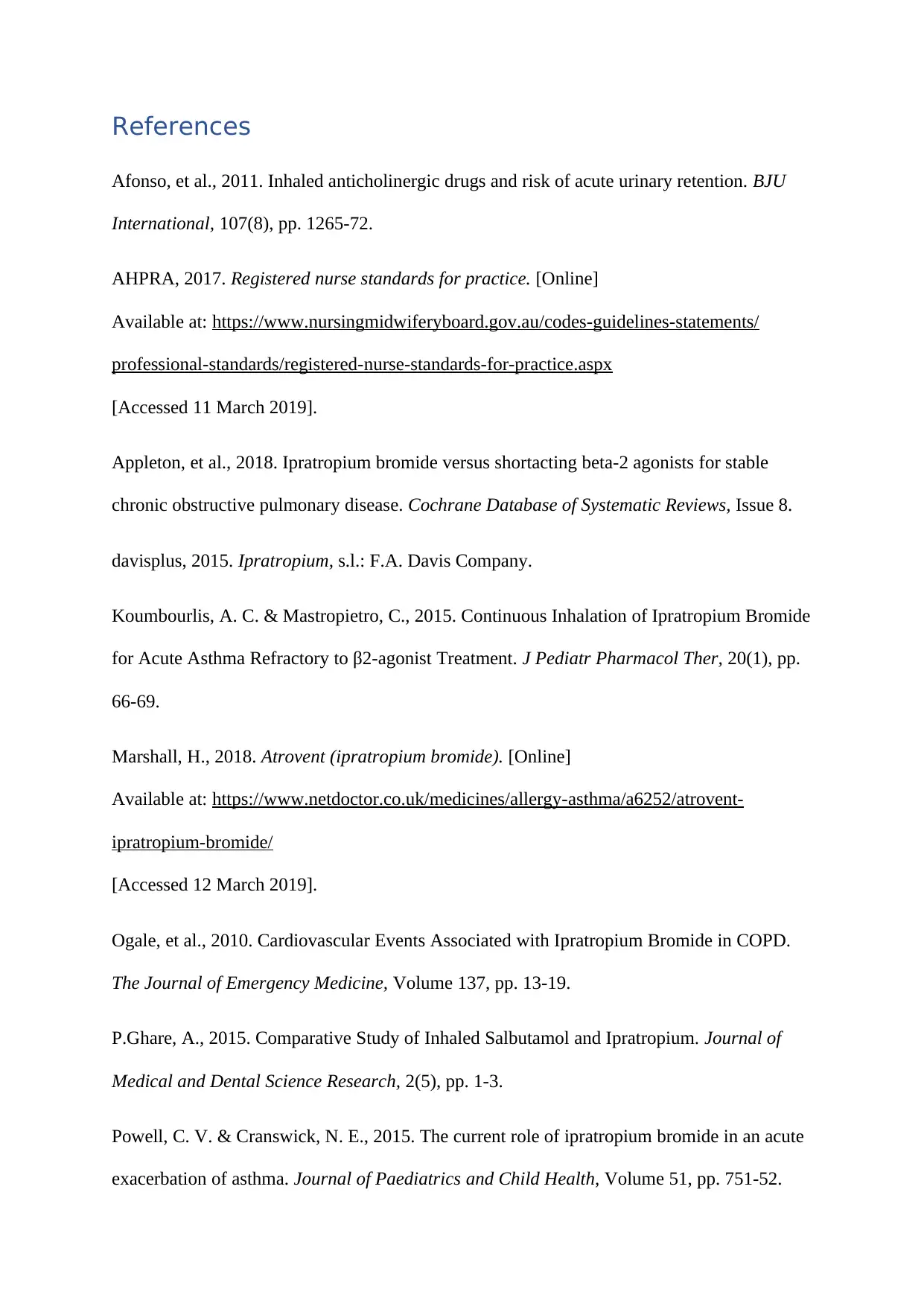
References
Afonso, et al., 2011. Inhaled anticholinergic drugs and risk of acute urinary retention. BJU
International, 107(8), pp. 1265-72.
AHPRA, 2017. Registered nurse standards for practice. [Online]
Available at: https://www.nursingmidwiferyboard.gov.au/codes-guidelines-statements/
professional-standards/registered-nurse-standards-for-practice.aspx
[Accessed 11 March 2019].
Appleton, et al., 2018. Ipratropium bromide versus shortacting beta-2 agonists for stable
chronic obstructive pulmonary disease. Cochrane Database of Systematic Reviews, Issue 8.
davisplus, 2015. Ipratropium, s.l.: F.A. Davis Company.
Koumbourlis, A. C. & Mastropietro, C., 2015. Continuous Inhalation of Ipratropium Bromide
for Acute Asthma Refractory to β2-agonist Treatment. J Pediatr Pharmacol Ther, 20(1), pp.
66-69.
Marshall, H., 2018. Atrovent (ipratropium bromide). [Online]
Available at: https://www.netdoctor.co.uk/medicines/allergy-asthma/a6252/atrovent-
ipratropium-bromide/
[Accessed 12 March 2019].
Ogale, et al., 2010. Cardiovascular Events Associated with Ipratropium Bromide in COPD.
The Journal of Emergency Medicine, Volume 137, pp. 13-19.
P.Ghare, A., 2015. Comparative Study of Inhaled Salbutamol and Ipratropium. Journal of
Medical and Dental Science Research, 2(5), pp. 1-3.
Powell, C. V. & Cranswick, N. E., 2015. The current role of ipratropium bromide in an acute
exacerbation of asthma. Journal of Paediatrics and Child Health, Volume 51, pp. 751-52.
Afonso, et al., 2011. Inhaled anticholinergic drugs and risk of acute urinary retention. BJU
International, 107(8), pp. 1265-72.
AHPRA, 2017. Registered nurse standards for practice. [Online]
Available at: https://www.nursingmidwiferyboard.gov.au/codes-guidelines-statements/
professional-standards/registered-nurse-standards-for-practice.aspx
[Accessed 11 March 2019].
Appleton, et al., 2018. Ipratropium bromide versus shortacting beta-2 agonists for stable
chronic obstructive pulmonary disease. Cochrane Database of Systematic Reviews, Issue 8.
davisplus, 2015. Ipratropium, s.l.: F.A. Davis Company.
Koumbourlis, A. C. & Mastropietro, C., 2015. Continuous Inhalation of Ipratropium Bromide
for Acute Asthma Refractory to β2-agonist Treatment. J Pediatr Pharmacol Ther, 20(1), pp.
66-69.
Marshall, H., 2018. Atrovent (ipratropium bromide). [Online]
Available at: https://www.netdoctor.co.uk/medicines/allergy-asthma/a6252/atrovent-
ipratropium-bromide/
[Accessed 12 March 2019].
Ogale, et al., 2010. Cardiovascular Events Associated with Ipratropium Bromide in COPD.
The Journal of Emergency Medicine, Volume 137, pp. 13-19.
P.Ghare, A., 2015. Comparative Study of Inhaled Salbutamol and Ipratropium. Journal of
Medical and Dental Science Research, 2(5), pp. 1-3.
Powell, C. V. & Cranswick, N. E., 2015. The current role of ipratropium bromide in an acute
exacerbation of asthma. Journal of Paediatrics and Child Health, Volume 51, pp. 751-52.
Paraphrase This Document
Need a fresh take? Get an instant paraphrase of this document with our AI Paraphraser

Wiley, F., 2015. What Is Atrovent (Ipratropium)?. [Online]
Available at: https://www.everydayhealth.com/drugs/atrovent
[Accessed 12 March 2019].
Available at: https://www.everydayhealth.com/drugs/atrovent
[Accessed 12 March 2019].
1 out of 8
Your All-in-One AI-Powered Toolkit for Academic Success.
+13062052269
info@desklib.com
Available 24*7 on WhatsApp / Email
![[object Object]](/_next/static/media/star-bottom.7253800d.svg)
Unlock your academic potential
© 2024 | Zucol Services PVT LTD | All rights reserved.


